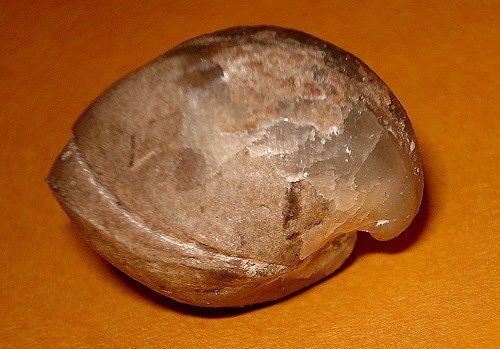|
Data:
This fossil was found in a field stone.
The stone was taken out of a field outside of Stratford Ontario.
The fossil is about 29mm long, 24mm wide by about 22mm high.
Send
Ideas to:
Lilka
Identified as a brachiopod.
- I was wondering if it could be either a Waconella or a Gypidula?
Thank you for your help, ...Lilka
|
|
Identified:
Discussions:
-
This is not a mollusk, it is a brachiopod of some sort. ...Susan
H.
-
Looks like a brachiopod, but a couple more photos will help. ...Allen
A.
-
I'm no expert, but it looks a little like Protocardia.
-
Although your fossil is a bivalved shell, it is not a mollusk.
It is a brachiopod, a completely different sort of a creature with
very different anatomy, and not at all like the clam or bivalve
animal we'd expect from looking at it. The little spout-like or
beak-like part of the shell on the right of the shell contains a
hole through which extends a bundle of threads by which the animal
attached itself to a rock or other fixed object on the substrate.
This thread bundle is called a byssus. The animal feeds by opening
its shell and waving > arm-like appendages (called brachia) towards
its opening, creating a current of water which hopefully brings
tiny bits of food into its mouth.
The brachiopod was commonly called a "lamp shell because it
was once used as a tiny oil lamp. How? If you had such a shell (don't
use your fossil) you would use what is pictured here as the top
half. Turn it over so that the spout-like protuberance points up.
Use only that half of the shell for your lamp. Pour lamp oil in
the bowl of the shell and insert a little cotton wick into the spout.
Light the wick and voila, you have a tiny lamp.
The brachiopods are also very important in geology. They changed
a lot over time, evolving many species. Some of these are used by
geologists as "index fossils" to dtermine the age of a
geological formation: a species may be known to live only from a
certain point in time to > another point in time. If the rock
contains a particular index fossil brachiopod, then it is certain
to be of that age.
There are many different shapes and sizes and types of brachiopods.
I suggest you research them on the web.
Best wishes, ...Lynn S.
-
I am not specialist, more its fossil material seems to correspond
to a brachiopod !
Cheers !! ... Ignacio
-
It looks like it could be a brachiopod. More pictures would help.
Jack D.
-
Hi, This fossil is some kind of brachiopod. It is not a mollusk.
best, ...Susan H.
-
Due to glaciers, a field stone in Ontario could have come from
any number of source areas, so it's hard to guess what a likely
age would be. An easy way to tell it's a brachiopod is the fact
that the valves are top and bottom (plane of symmetry goes through
the shells) rather than left and right, as in bivalves. The end
of the beak, pointing down in the picture, often has an obvious
hole in brachiopods. More specifically, the fossil is an articulate
brachiopod, but that doesn't narrow it down much. Another angle
or two would help show the shape and sculpture. .. Dr. David C.
-
Definitely a brachiopod. It looks like a terebratulid, but if it's
from Ontario it'll be one of those Paleozoic spiriferoids which
superficially resemble terebratulids.
-
Definitely a brachiopod, phylum Brachiopoda, superfamily Spiriferoidea.
It looks like a member of Terebratulida, but if it's from the north
it has to be Paleozoic. I guess the only way to really tell is to
grind it down on a diamond lap & see if the lophophore (shelly
support for the filtering
apparatus) is a terebratulid loop or a spiriferoid double-cone spiral.
-
I was wondering if it could be either a Waconella or a Gypidula?
Thank you for your help, ...Lilka
|

